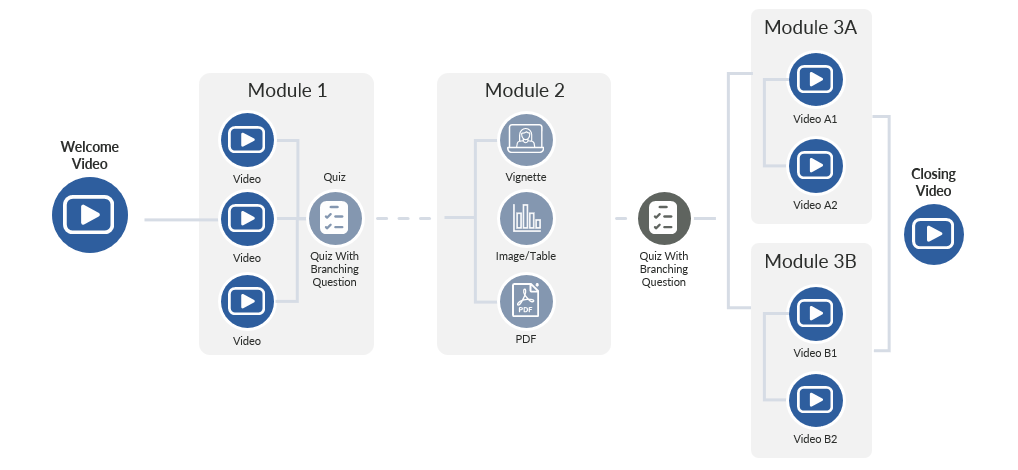Digital launches of new treatments can be a potent way to increase awareness about a new therapy, but often brands are unsure how to keep health care providers engaged throughout the long sessions needed to disseminate the necessary clinical information. There is a great deal of knowledge providers need to absorb in these long-form programs, and capturing mindshare is no easy task when providers have limited time and attention. Getting clinicians and specialists to attend programs is becoming increasingly competitive, and it’s not uncommon to see drop-off in participation during lengthy sessions.
However, by applying adult learning principles, we’ve discovered that it’s possible to engage providers longer and help them retain more knowledge about a therapy.
The first step is to consider your goals. The intention isn’t to increase the number of clicks into a program, but to educate providers through innovative means.
Use engagement tools so providers stay longer and return more frequently
Live Q&As, patient/caregiver vignettes, polling, and surveys have been shown to increase the level of engagement during programs. Recent programs have seen between 475 and 650 additional engagements through polling and surveys, gaining valuable insight from clinicians. National broadcasts hosted on PlatformQ Health learning channels are led by preeminent specialists in their field. These are a major draw for providers to be able to get their questions answered by key opinion leaders in real time.
Additionally, case-based activities have proven highly effective for creating an immersive learning experience. These clinically relevant, real-world cases allow providers to practice decision making and apply evidence-based feedback through practice exercises.
Apply micro-engagement to break down content
Micro-engagement or microlearning is an approach involving breaking down complex topics into short-form units of content. This appeals to many providers, freeing them to quickly connect with snippets of information over small periods of time and providing the option to return as many times as they like. It may seem counterintuitive, but providing smaller pieces of content in chapters keeps providers engaged longer. Multi-chapter programs result in 20% higher time in programs, with 45% of participants watching more than one chapter.
Consider the content delivery
When it comes to program effectiveness, it’s essential to make the language as authentic as possible. Programs that allow for unscripted content perform far better than those that don’t. However, even programs that require scripting can also be produced in a more natural way by using the right transitions and building on back and forth between speakers. This makes for a more natural presentation that keeps providers’ attention longer.
Using a moderator is an excellent way to achieve this authenticity. The right moderator can make all the difference both for putting speakers at ease and helping to create a more lively discussion.
Connect with providers at the right point in their learner journey
The most powerful way to keep providers focused on your content is to deliver information that is appropriate for them, whether it’s based on their specialty or their level of competency in a particular topic. That’s where workflows come in. By applying workflows, we can tailor the path for each provider based on demographic information as well as behavioral information, such as their response to an online poll or quiz. This way, providers can take customized journeys based on their actions.

Workflow trees make it possible to respond automatically to each provider’s interaction. By tailoring content based on what the provider is doing, we can offer information that is much more applicable, and more interesting to each individual. This may also involve sending “hooks” or reminders to encourage the provider to watch as much as possible.
Reinforce education through feedback loops
Reinforcement strategies are a proven way to help providers retain knowledge. One way to do so is by providing brief online surveys or quizzes providers can complete to receive a behavior-based response. If, for example, the provider completed a quiz and meets a certain threshold, they would move on to a follow-on module of the program, whereas if they didn’t meet the threshold they could be directed to content that reinforces concepts previously described. This type of branching logic offers a way for providers to come out on the other side of a program confident in what they’ve learned. But more importantly, this results in learning that sticks!
Ensure consistent representation of ISI throughout
When hosting branded programs, people often worry about how to ensure compliance in both the layout, and the speaker’s presentation of the content. The good news is that there are compliant ways to display important safety information (ISIs) consistently throughout the program. We use an always-there ISI wrapper to provide the appropriate balance across chapterized content. This approach provides legal and FDA compliance while freeing the pharmaceutical brand to display content in a way that’s more appealing to providers.
Skip highly-produced videos
We’ve found that programs with an educational, news-style format tend to perform better than those that are highly produced. In an era where many of us tend to tune out advertisements, programs that appear too slick or promotional are less appealing to providers, who are seeking out statistics and more clinical specifics about a therapy.
Educate at the right time
Think about the provider and what they would like to learn in conjunction with the brand message. Ensure there is something to share, such as a new study or new indication. If there is something new and exciting to share about a therapy, having a basic video program might work just fine. If you’re producing an on-demand program for an existing medication, you may want more interactive features such as a panel discussion and/or polling to spark interest.
Tip: Polling isn’t just beneficial for engaging providers. It can be valuable market research for the brand team.

